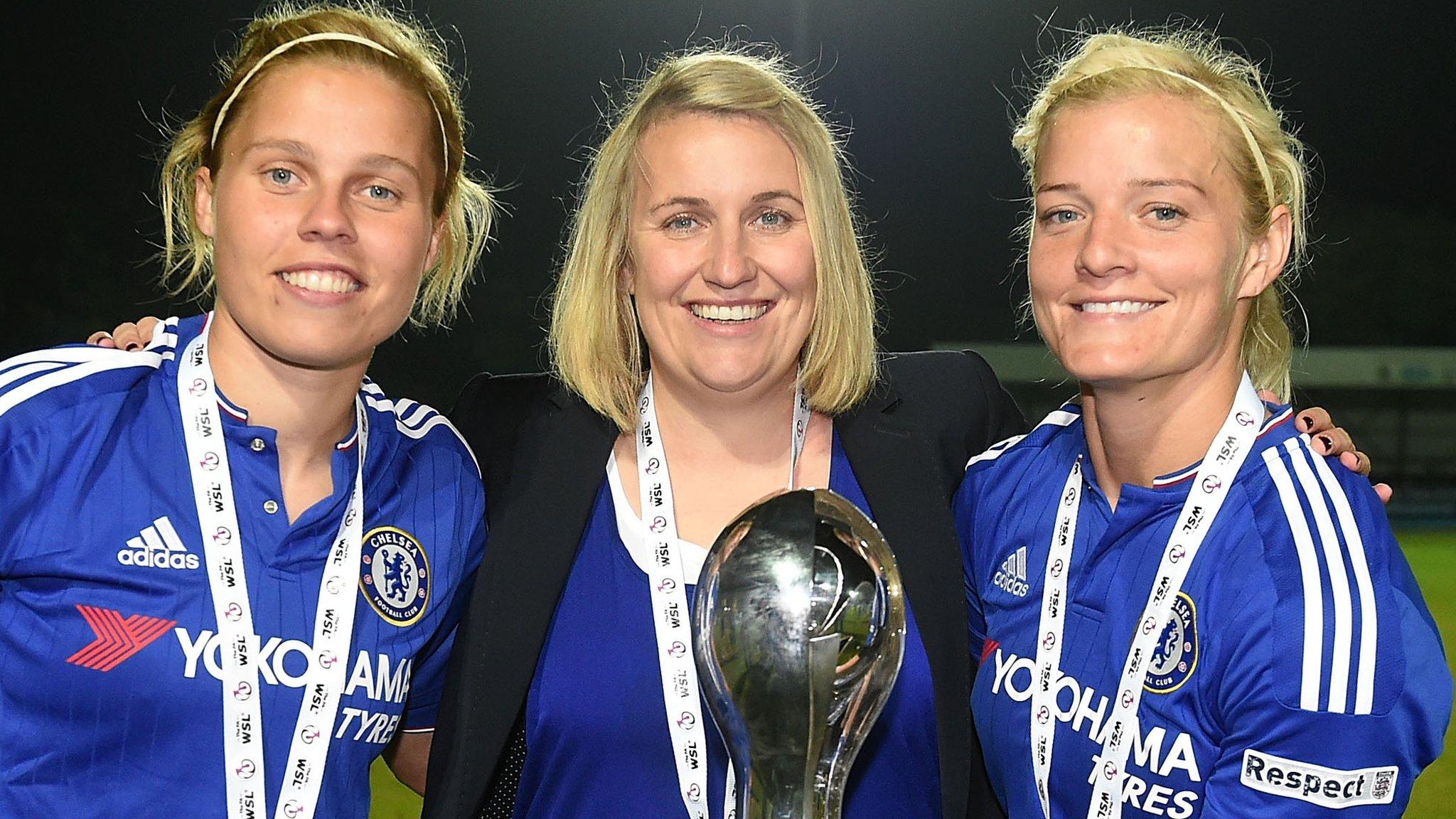WSL crowds: Manchester City average more than 2,000 but three top clubs see decreases
- Published
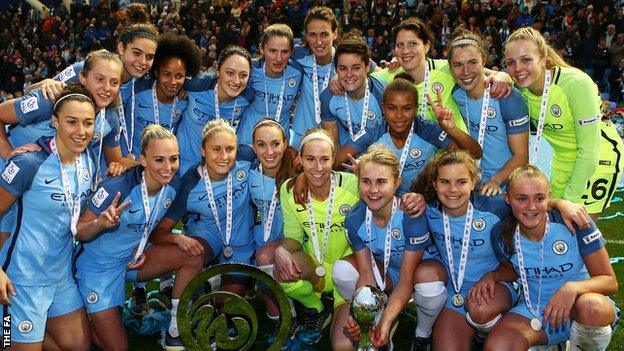
Manchester City Women won the WSL 1 title for the first time in October
Manchester City have become the first women's club in British football to average crowds of more than 2,000 over a season - but three Women's Super League One rivals saw numbers drop.
City, who won the expanded nine-team competition in October, saw attendances increase by 50% to 2,253 in 2016.
BBC Sport figures show overall average crowds grew by 1.5%, less than the 5% reported by the Football Association., external
Liverpool, Sunderland and Notts County all saw home support fall.
In total, BBC Sport found 78,641 spectators attended 72 matches across the league.
Overall, more than 18,000 extra spectators attended matches in the expanded nine-team competition, which included 16 more matches.
The FA equates averages on a round-by-round basis.
BBC Sport figures are equated on a match-by-match basis.
Baroness Sue Campbell, the FA's head of women's football, said Manchester City's attendance figures were "terrific" but it was a "mixed picture" overall.
After meeting each of the 19 Women's Super League One and Two clubs, Baroness Campbell said more could be done to improve numbers across the two competitions by focusing on the needs of individual clubs, from marketing to local player development.
"Rather than have a one-size-fits-all approach, we will look to tailor support, looking at the challenges and situations at each club," the former boss of UK Sport told BBC Sport.
She also said the FA is "committed" to doubling attendances by 2020.
The ups and downs
While Notts County are one of just four top-flight clubs with an average attendance of more than 1,000, their numbers have dropped by almost 17%.
Sunderland, in their second top-flight season, experienced the biggest decline - almost 24% to 710 - while Liverpool averaged gates of 724, a fall of almost 10%.
Liverpool's average was boosted by a crowd of 1,159 - their highest attendance of the season - for a 5-3 defeat to Arsenal on the final day of their campaign.
While on-field results have an impact on attendances, Baroness Campbell said Liverpool also suffer from playing away from their fanbase, an artificial pitch in Widnes that has been criticised by some WSL players.
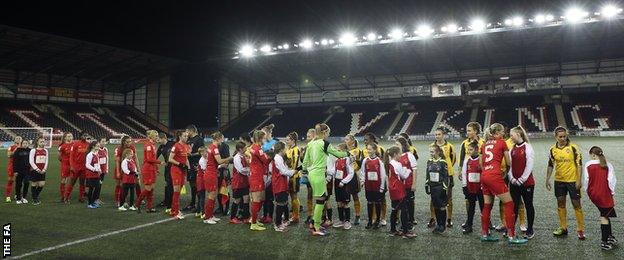
Liverpool Ladies play their home games at the Select Security Stadium in Widnes - 12 miles from Anfield
"For Liverpool, location is a real issue," she said. "We need to work better on making sure WSL clubs are at facilities that are appropriate and located near their local communities.
"A lot of training facilities are good, but some competition facilities need rethinking. We are working locally and nationally to ensure these clubs are playing on good surfaces and at good facilities as close to their local support as possible."
Reading and Doncaster, both promoted from Women's Super League Two last season, increased attendances, as did Birmingham City, Arsenal and runners-up Chelsea, who were the second-best supported club with an average attendance of 1,593.
Champions target bigger crowds
Manchester City, in just their third season in WSL 1, won their first league title and averaged the league's biggest crowds for a second straight campaign.
Gavin Makel, head of women's football at City, says the club is now setting ambitious new targets.
"I'm absolutely delighted," Makel told BBC Sport. "Hopefully next year we can continue and get even more.
"We now want to look ahead and try to get 3,000 on average because that's where the game needs to get to."
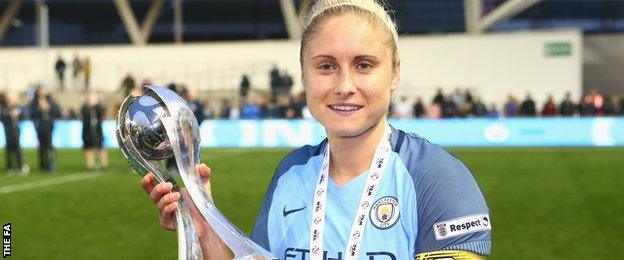
Steph Houghton, pictured with the WSL 1 trophy, captained England to third place at last year's World Cup
City, led by England captain Steph Houghton, have the highest concentration of senior national team players in their side, with eight included in the 23-player squad for October's international matches against France and Spain.
"On-pitch success will always help, playing good football," said Makel. "It is all well and good being able to put a Manchester City crest on something and expect people to support it, but you have got to feel some kind of affinity towards it."
City's popularity is an example for other clubs to follow, according to a Notts County Ladies spokesperson.
"It demonstrates the potential attendances that are out there and that can only act as encouragement for all the clubs who aren't reaching those heights."
Baroness Campbell has said the FA will bring clubs together to encourage them to share ideas, learning from Manchester City - one of British football's richest clubs - and Yeovil.
The WSL 2 champions have less than a 10th of City's turnover but have managed to win promotion and increase attendances by almost 60% to an average of 742.
'Scheduling frustration'
Notts County, the only WSL 1 club who experienced a decline this season that was willing and available to talk to BBC Sport, put their "slight drop" down to a number of factors, including sporadic scheduling of matches and absence of a cup run, having reached two cup finals in 2015.
On four occasions, there were breaks of a month or more between home fixtures at Meadow Lane.
"The scheduling of matches has been a frustration for both clubs and the league since the inception of the FA WSL," said a club spokesperson.
"We understand that there are many factors, some out of the club's control, which can attribute to a slight drop in our average attendance.
"Last season's achievements of reaching the final in both cup competitions certainly helped to create a momentum and build attendances for Notts County.
"Without having a run in either competition this season, it has undoubtedly had an effect on our attendance."
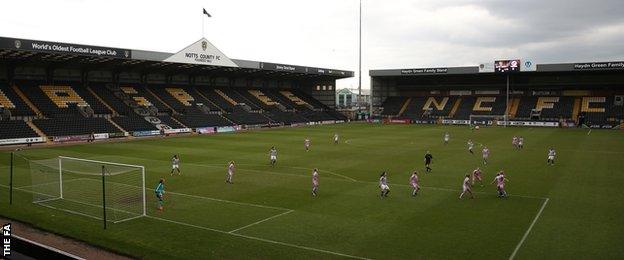
Notts County Ladies, who averaged 1,100 in 2016, play at the 19,500-capacity Meadow Lane
Hopes are high that the switch from a summer league to a winter competition from the 2017-18 season will help scheduling of matches.
But with change comes new challenges, as there will be a shortened Summer Series before the campaign starts in September 2017.
"With the winter season still 10 months away, it's hard to tell yet what the effect on attendances will be," said a Notts spokesperson.
"We understand that any adverse weather could have an effect. However, we are also aware that a consistent run of fixtures will have a positive impact on the attendances."
Second-tier growth
The FA reports a 30% increase in WSL 2 attendances, up to 443 from 341 in 2015.
Four of the eight clubs - Watford, London Bees, Durham and Sheffield Ladies - average crowds of less than 400, with the attendance of 207 at Watford v Bristol City the single lowest attendance in England's top two divisions.
Oxford United's crowds increased by 85%, the biggest in the WSL, while seven clubs are in double-digit growth.
Highs and lows
The highest single crowd for a WSL match in 2016 was the 4,096 that watched Manchester City clinch their first title with victory over Chelsea.
That was significantly up from the 3,180 that watched City host Notts County in 2015, but still shy of the WSL's all-time record of 5,052 that saw Arsenal face Chelsea at the Emirates Stadium in 2012.
The lowest single attendance in the top flight this season was 395, who turned out to watch Birmingham City host Reading.
That represented an increase on 2015's lowest top-flight crowd of 331.
WSL 1 attendance average | |||
|---|---|---|---|
Club | 2015 | 2016 | % difference |
Manchester City | 1,500 | 2,253 | 50.2 |
Chelsea | 1,402.7 | 1,593.1 | 13.6 |
Birmingham City | 717.3 | 791.5 | 10.4 |
Arsenal | 1,177.7 | 1,209.1 | 2.7 |
Liverpool Ladies | 799.7 | 724 | -9.5 |
Notts County | 1,323.6 | 1,100 | -16.9 |
Sunderland | 932.4 | 710 | -23.9 |
* Average figures of WSL 1 attendances for those sides in the league in 2015 and 2016.
- Published12 July 2016
